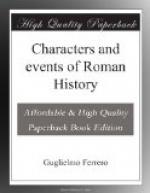Foremost among all nations of the Empire, at the centre, Italy rapidly consolidated its fortune and its domination. After the mad plundering of the times of Caesar, followed methodical exploiting. Italy attracted to itself by the power of political leadership the precious metals and wares of luxury from every part of the Empire; the largest quantity of these things passed through Rome, before being scattered throughout the peninsula in exchange for the agricultural and industrial products of Italy, consumed in the capital. Consequently the middle classes and many cities grew rich, especially the cities of the Campania, Pompeii, Herculaneum, Naples, Pozzuoli, through which passed all the trade between Italy and Egypt. In addition, Italy found an abundant source of income in the exportation of wine and oil.
In short, having at last emerged from revolution, the peoples of Italy rallied around Rome and the imperial power, united and relatively content. At the same time, the provinces began among themselves, about Italy, a great interchange of merchandise, men, ideas, customs, across the Mediterranean. Rome and Italy were invaded by a crowd of Orientals, slaves, freedmen, merchants, artisans, litterati, artists, acrobats, poets, adventurers; and contemporaneously with Rome and Italy, the agricultural provinces of the West, especially those along the Danube. Rome did not conquer the barbarous provinces of Europe for itself alone; it conquered them also for the East, which, in Mesia, Dalmatia, Pannonia, among those barbarians growing civilised and eager to live in cities, found customers for their industries in articles of luxury, for their artists, teachers of literature, and propagandists of religion.
We are therefore able to explain to ourselves why, beginning from the time of Augustus, all the industrial cities of the Orient—Pergamon, Laodicea, Ephesus, Ierapolis, Tyre, Sidon, Alexandria—entered upon an era of new and refulgent prosperity. Finally, we add the singular enriching of two nations, whose names return anew united for the last time, Egypt and Gaul. To all the numerous sources of Gallic wealth there is to be added yet another, the importance of which is easier to understand after what I have said on the development of the Empire. Pliny tells us that all Gaul wove linen sails. The progress of navigation, a consequence of the progress of commerce, much increased the demand for linen sail-cloth, something that explains the spread of flax cultivation in Gaul and the profit derived from it.
As to Egypt, it not only found in the pacified empire new outlets for its old industries, but also succeeded in engaging a large part of the new commerce with the extreme Orient, which was at this time greatly on the increase. From India and China were imported pearls, diamonds, silk fabrics; for the use of these wares gained largely during this century, as it has done in recent times in Europe and America; perfumes were also imported, and rice, which served as a medicament and to prepare dishes of luxury.




